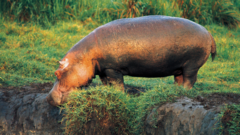The anthrax outbreak raises concerns for local communities, prompting officials to advise residents to steer clear of wildlife and boil drinking water sourced locally. Historically, anthrax poses a low risk of widespread transmission, primarily existing as dormant spores in soil until they penetrate an animal through wounds or inhalation. Virunga has been both a popular tourist destination and a battleground for rebel groups vying for control over the area’s abundant resources, which has historically endangered many local rangers. Conservation efforts have sought to restore hippo numbers, which have dramatically declined from over 20,000 due to previous poaching and conflict.
Amid the ongoing struggles to preserve wildlife in the park, the recent anthrax outbreak highlights the delicate balance between biodiversity and external threats in Virunga National Park.
Conservationists and local authorities continue to monitor the situation closely, prioritizing the health of both the wildlife and human populations living in proximity to this vital ecosystem.
Amid the ongoing struggles to preserve wildlife in the park, the recent anthrax outbreak highlights the delicate balance between biodiversity and external threats in Virunga National Park.
Conservationists and local authorities continue to monitor the situation closely, prioritizing the health of both the wildlife and human populations living in proximity to this vital ecosystem.


















